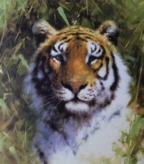


We will endeavour to better any quote and give you the finest possible service
99.9% of signed, limited editions shown below are in stock, although we usually have only one print of each title
For prices and information please call us 01623 799 309 or email administrator@davidshepherd.com
"Where are the Prices"
Most of David Shepherd's limited edition signed prints are between 10 and 50 years old.
We often have only one of each title.
It can be months or sometimes years before we come across the same title
The stock and prices change frequently
The condition is extremely important, we try to keep only work that is in near mint condition
A phone call or email will quickly provide you with the prices of any curent titles you may be interested in
EMAIL:- administrator@davidshepherd.com
Telephone England 01623 799 309
or mobile 07974 371 255
DavidShepherd,FRSA, CBE, OBE, FRGS,.
He is internationally known as one of the world's leading wildlife artists,
and also a passionate conservationist and he freely admits that he owes much success to the animals he paints.
Prolific in output as a painter with a brimful of stories and anecdotes, he is an extrovert who enjoys talking,
and enjoys being known as a natural promoter and an ardent ambassador for conservation; it's the way he is.
Explaining that he became an artist in childhood because he couldn't do anything else.
"My life was a total disaster until I was 20 years old. My one and only wish was to have a job as a gamewarden, so when I'd finished my education,
I went rushing out to Kenya with the incredibly arrogant idea that I was God's gift to the NationalParks. It was a disaster. I knocked on the door of the
Head Gamewarden in Nairobi and said, 'I'm here, can I be a game warden?' I was told I wasn't wanted.
My life was in ruins; that was the end of my career in three seconds flat."
"Up to that point, my only interest as an artist was to escape from the rugger field. The game was compulsory at school and I was terrified of it.
I couldn't see any fun in being buried under heaps of bodies in the mud and having my face kicked in. I fled into the art department where it was more
comfortable and painted the most unspeakably awful painting of birds."
Deflated and homesick, he took a job as a receptionist in a hotel on the Kenya coast; the salary was one pound a week.
"So there I was at Malindi on the Kenya Coast in this hotel. I painted some more bird paintings on plasterboard, and I sold seven of them for £10 each to the
culture-starved inhabitants of the town and paid my passage home to England on a Union Castle steamer."
Arriving home, penniless, he had two choices,Mr Shepherd decided he could either become a busdriver or anartist.
Since he suspected the majority of artists starved in garrets, life as a driver seemed the safer bet.
"But my dad was marvellous and said that if I really wanted to be an artist, I'd better get some training.
The only school we knew anything about was The SladeSchool of FineArt, London, so I sent them my first bird painting."
The Slade, too, turned him down. He had no talent, they said, and he wasn't worth teaching.
The driving job was looking more likely all the time, except for a 'chance meeting that changed my life'.
At a London cocktail party, the young artist was introduced to Robin Goodwin.
Robin was a professional painter who specialised in portraits and marine subjects. (considered to have been one
of the finest marine painters of this century). He didn't and wouldn't take students, Robin told him, but said he would have a look at the work.
"The next day, I trotted up to the studio in Chelsea and a miracle happened. I showed him that very first bird picture, which I still have and,
for reasons that I have never been able to understand, he decided to take me on. I owe all my success to that man.
He is responsible for my being where I am today."

